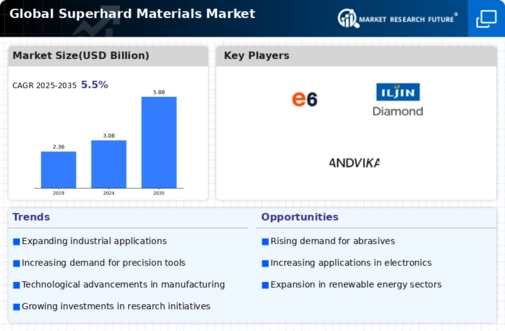Top Industry Leaders in the Superhard Materials Market
 The superhard materials market, a glittering landscape where the toughest contenders clash, is experiencing a surge of activity driven by technological advancements, diverse applications, and a relentless pursuit of ever-greater hardness. Understanding the strategies, factors influencing market share, and recent developments in this diamond-encrusted arena is crucial for any player seeking to claim their rightful place at the top.
The superhard materials market, a glittering landscape where the toughest contenders clash, is experiencing a surge of activity driven by technological advancements, diverse applications, and a relentless pursuit of ever-greater hardness. Understanding the strategies, factors influencing market share, and recent developments in this diamond-encrusted arena is crucial for any player seeking to claim their rightful place at the top.
Giants of the Gemstone Game:
The superhard materials market boasts a diverse range of players, each wielding their cutting-edge technologies and established reputations:
-
Element Six: A global leader in diamond technology, renowned for its iconic De Beers brand and expertise in synthetic diamond production. -
Kennametal: A titan of the industry, offering a comprehensive portfolio of superhard materials including cubic boron nitride and tungsten carbide. -
Saint-Gobain: A French multinational giant, specializing in high-performance ceramics and abrasives, including superhard materials for cutting and grinding. -
Seiko Instruments: A Japanese powerhouse, known for its innovative synthetic diamond production methods and advanced tool development. -
Sumitomo Electric Industries: A diversified Japanese conglomerate, holding a strong presence in the superhard materials market through its abrasives and cutting tools divisions.
Strategies Sharper than a Diamond Blade:
Like skilled gem cutters, each player employs unique strategies to carve out their market share:
-
Innovation: Continuous research and development of new superhard materials with enhanced properties like hardness, thermal stability, and wear resistance is key to staying ahead. -
Diversification: Offering a broad range of superhard materials and tools catering to diverse applications across industries fosters market reach and customer loyalty. -
Vertical Integration: Controlling the entire supply chain, from raw materials to finished tools, can create cost-efficiencies and secure reliable product quality. -
Strategic Partnerships: Collaborations with research institutions, tool manufacturers, and end-users can accelerate innovation and open up new market opportunities. -
Sustainability Focus: Developing eco-friendly production processes and utilizing recycled materials resonates with environmentally conscious customers.
Market Facets Brighter than a Cubic Zirconia:
Several factors influence the direction and growth of the superhard materials market:
-
Technological Advancements: Breakthroughs in diamond synthesis, sintering techniques, and tool coating technologies are pushing the boundaries of hardness and performance. -
Industrial Diversification: Increasing demand from diverse industries like aerospace, automotive, electronics, and energy generation expands market potential. -
Infrastructure Development: Growing investments in infrastructure projects worldwide fuel demand for superhard tools for drilling, cutting, and construction. -
Regional Dynamics: Different regions exhibit distinct growth patterns and application preferences, demanding tailored market strategies. -
Environmental Regulations: Stringent regulations on environmental impact are promoting the development of sustainable superhard materials and production processes.
List of the Major Companies:
Element Six (Luxembourg), Iljin Diamond (South Korea), Sandvik AB (Sweden), SF Diamond Co Ltd (China), Henan Huanghe Whirlwind Co Ltd (China), Henan Yalong Superhard Materials Co. Ltd (Japan), Funik Ultrahard Material Co. Ltd (China), Sumitomo Electric Industries Ltd (Japan), CR GEMS Superabrasives Co. Ltd (China), WorldWide Superabrasives LLC (China), Anhui Hongjing New Materials Co. Ltd (China), and others.
Recent Developments:
-
January 2024: Sumitomo Electric Industries announces plans to invest in a new production facility for cubic boron nitride superhard materials in China. -
February 2024: A group of researchers from MIT unveils a new type of synthetic diamond with unparalleled hardness, potentially revolutionizing the industry. -
March 2024: The European Union proposes stricter regulations on the use of certain industrial abrasives due to environmental concerns, prompting the development of eco-friendly superhard alternatives. -
April 2024: A consortium of leading superhard materials manufacturers launches a collaborative research initiative to develop next-generation materials for sustainable energy applications.

